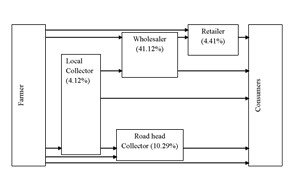Economic analysis of mushroom enterprise in Chitwan district, Nepal
Abstract
The majority of the population (66%) in-country “Nepal” are engaged in agriculture. However, domestic production finds it difficult to meet the annual demand of the people. Hence, people are moving from subsistence agriculture to embrace mushroom farming. This study focuses on economic analysis and analysis of the present status of mushroom farming and enterprise in this country. The study was conducted in the land area of Kalika Municipality and Bharatpur Metropolitan City. 30 mushroom farmers with two huts and at least three years of experience were selected from the study area. The primary data were collected through face-to-face interviews with the farmers, focus group discussion (FGD) and key informant interviews (KII). The secondary data was collected through various published articles and documents. The data analysis was done using basic statistics and a regression function. The benefit-cost ratio is 2.54 and a high gross margin is NRs.490,876.65 per kattha per year. The return to scale (RTS) is 0.80. Five marketing channels are present among which wholesalers and local collectors contributed the highest percentage of the share. However, the dominance of the intermediaries, timely unavailability of inputs, price fluctuation, disease and pest infestation were the major constraints. Disease and pest control, formation of the producer organization, improvised cultivation practices, timely and affordable availability of quality can be the major solution measures. Whereas, suitable climatic conditions, high productivity and growing market demand are the strengths of mushroom production in this study area. Mushroom farming is found to be a profitable business concerning competitive and comparative markets.
Keywords:
Benefit cost ratio analysis, Economic analysis, Marketing channel, Mushroom cultivation, SWOT analysisDownloads
References
Bhandari, R., Dhungana, R., & Neupane, P. (2021). Benefit-cost ratio analysis of pleurotus mushroom cultivation using different substrates in Campus of Live Sciences, Dang, Nepal. Food & Agribusiness Management, 2(2), 85-87.
DoIED. (2013). Directorate of Industrial Entomological Development
Holland, R. (1998). Selling price, gross margin and mark-up determination. Agricultural Development Centre (ADC) information, (12).
Kumar, V., Valadez-Blanco, R., Kumar, P., Singh, J., & Kumar, P. (2020). Effects of treated sugar mill effluent and rice straw on substrate properties under milky mushroom (Calocybe indica P&C) production: Nutrient utilization and growth kinetics studies. Environmental Technology & Innovation, 19, 101041, https://doi.org/10.1016/j.eti.2020.101041
Kumar, V., Kumar, P., Singh, J., & Kumar, P. (2021). Kinetics of nutrients remediation from sugar industry effluent-treated substrate using Agaricus bisporus: mushroom yield and biochemical potentials. 3 Biotech, 11(4), 1-11. https://doi.org/10.1007/s13205-021-02712-z
Marglin, S. A. (2014). Public investment criteria (Routledge revivals): Benefit-cost analysis for planned economic growth. Routledge.
NARC. (2010). NARC’s Strategic Vision for Agricultural Research (2011-2030) National Agricultural Research Council, Khulmaltar, Nepal.
Pokhrel, C. P. (2016). Cultivation of oyster mushroom: a sustainable approach of rural development in Nepal. Journal of Institute of Science and Technology, 21(1), 56-60.
Poudel, S., & Bajracharya, A. (2011). Prospects and challenges of Mushroom cultivation in Nepal: A case study in Lakuri Bhanjyang, Lalitpur. Description: www.forestrynepal.org Published: August 30, 2011
Prajneshu (2008). Fitting of Cobb-Douglas production functions: Revisited. Agricultural Research Reviews, 21, 289-292.
Raut (2019). Current Status, Challenges and Prospects of the Mushroom Industry in Nepal. International Journal of Agricultural Economics, 4(4), 154-160, https://doi.org/10.11648/j.ijae.20190404.13
Shephard, R. W. (2015). Theory of cost and production functions. Princeton University Press.
Shrestha, J. B. (2014). Present Scenario and Prospects of Mushroom Cultivation in Nepal: Proceedings of the Seminar on Mushroom Consumption and Poisoning Risk. Directorate of Industrial Entomology Development Harihar Bhawan, Lalitpur
Singh, R. (2017). A Review on Different Benefits of Mushroom. IOSR Journal of Pharmacy and Biological Sciences, 12(1), 107-111.

Published
How to Cite
Issue
Section
Copyright (c) 2021 Agriculture and Environmental Science Academy

This work is licensed under a Creative Commons Attribution-NonCommercial 4.0 International License.

